-->
WDSU-TV ON AIR CELEBRITIES
Page 1
STARS OF THE EARLY DAYS OF WDSU-TV
*Gaines C. "Gay" Batson (D)
First TV Announcer in the Deep South
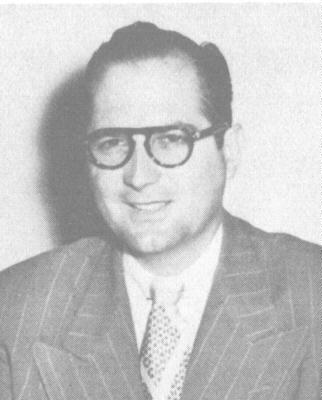
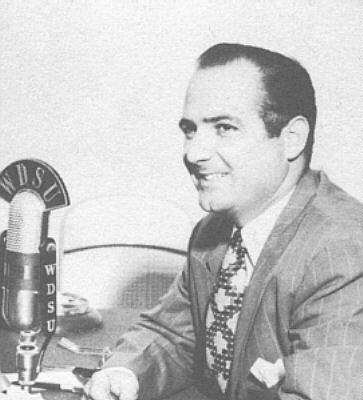
WDSU AM-FM-TV listners and viewers could immediately identify the deep,
melodius voice of Chief Staff Announcer Gay Batson. Batson had a fine
classical music background. He majored in Music at Wisconsin University.
Gay continued playing music while pursuing his career as a radio announcer.
He played trumpet in the American Legion Band in New Orleans. Gay came to
WDSU radio with 12 years radio experience. He was an avid ham (Amateur
Radio Operator W5EVR) as were many of the WDSU AM-FM-TV personnel. TV viewers will
remember his fine voice as the narration of the annual "Meeting of the Courts"
on Mardi Gras night.Batson also modeled and narrated for Motion Picture
Advertising, a New Orleans production company specializing in 35mm film
commercials featured in movie theaters throughout the country. He is also
remembered as the first TV announcer in the deep South. He was truly the
"Announcer's announcer" It should be noted that Gaines C. Batson acquired
the nickname "Gay" long before that name became a term indicating sexual
preference.
Gay advised youngsters, who wanted to enter the world of broadcasting, to
refrain from using vulgrities in ordinary conversation. He NEVER was heard to
use "cuss" words in daily converstation. "Shuckins" and "Oh! Foot!" were
about the most vulgar words he ever used. When asked about his restraint,
Gay responded: "If you don't use vulgar language in every day communication,
you won't forget and use them on the air." As an example of his restraint
and self-control, when a set completely collapsed while Gay was on camera
hosting a WDSU-TV "Dialing for Dollars" feature, Gay continued the program
as though nothing had happened. After the show was over, as Gay left the
studio, he was heard quietly mumbling; "Oh! Foot!"
Gay is now with that great TV station in the sky and is sincerely missed
by all in the broadcast community.
"Outdoors In Louisiana" sponsored by Jax Beer
Paul Kalman and Gay Batson
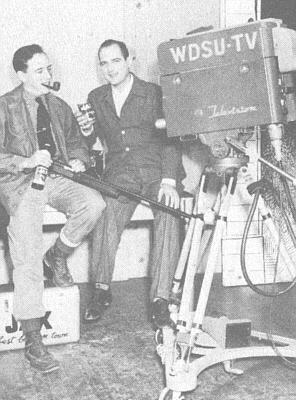 Paul Kalman was the host and Gay Batson was the show's announcer. All types
of outdoor activities were featured. Kalman was an ad-agency exec. Fishing
n Louisiana was a favorite topic for both Gay and Paul, who delighted in
presenting coverage of the annual Tarpon Rodeo at Grand Isle, LA.
Paul Kalman was the host and Gay Batson was the show's announcer. All types
of outdoor activities were featured. Kalman was an ad-agency exec. Fishing
n Louisiana was a favorite topic for both Gay and Paul, who delighted in
presenting coverage of the annual Tarpon Rodeo at Grand Isle, LA.
Notice the guys DRANK beer on the show. While, at that time, the FCC had
decreed that no beer would be consumed in beer commercials, there was no
regulation for programs. Hard liquor could not be advertised in
commercials but consumption could be shown in a dramatic presentation
program.
Woodrow "Woody" Leafer
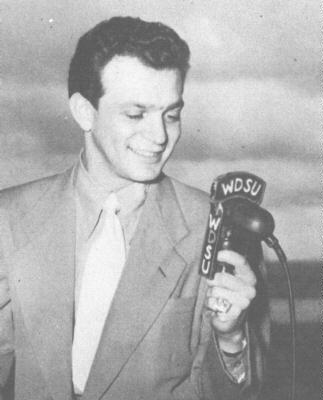 Woody leafer was the first staff announcer hired by WDSU-TV specifically for
TV booth announcer chores. He immediately proved to me much more valuable as
an on camera talent. He hosted a 15 minute comedy program called "Leave It To
Leafer." That title was seen on the TV screens of New Orleans many years before
the similar title "Leave It To Beaver" ever made its appearance. Many of the
Ch.6 staffers believed Woody had a photographic memory. He claimed his hobby
was memorizing the Pharmacist's Hanbook. Woody hosted several other programs,
among them was "The Golden Age Club" Shown in the picture below, Golden Agers
display their talents for Ken Muller's camera as host Woody watches and listens.
Woody leafer was the first staff announcer hired by WDSU-TV specifically for
TV booth announcer chores. He immediately proved to me much more valuable as
an on camera talent. He hosted a 15 minute comedy program called "Leave It To
Leafer." That title was seen on the TV screens of New Orleans many years before
the similar title "Leave It To Beaver" ever made its appearance. Many of the
Ch.6 staffers believed Woody had a photographic memory. He claimed his hobby
was memorizing the Pharmacist's Hanbook. Woody hosted several other programs,
among them was "The Golden Age Club" Shown in the picture below, Golden Agers
display their talents for Ken Muller's camera as host Woody watches and listens.
The "Golden Age Club" on Channel 6
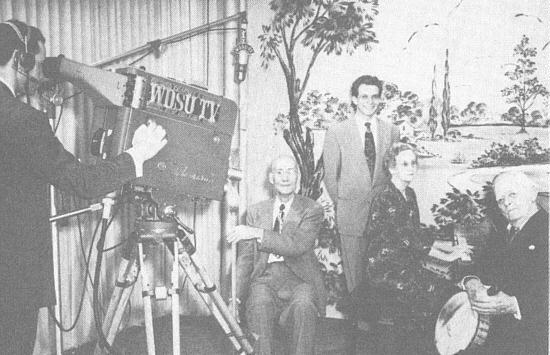
Woodrow "Woody" Leafer and Naomi "Nonie" Bryant
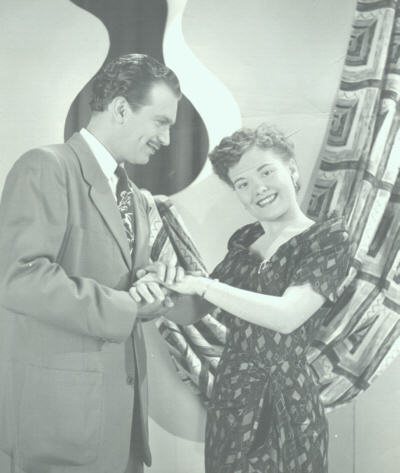
One of the earliest musical shows produced in the WDSU-TV studios on the 14th floor of the Hibernia Bank building featured a lovely lady of song, Naomi Bryant. "Nonie" is shown, in the above picture, with Announcer "Woody" Leafer performing on Miss Bryant's WDSU-TV program "Seeing Stars." "Nonie" later became the wife of New Orleans' Mr.Television,
Mel Leavitt.
Nonie goes western!
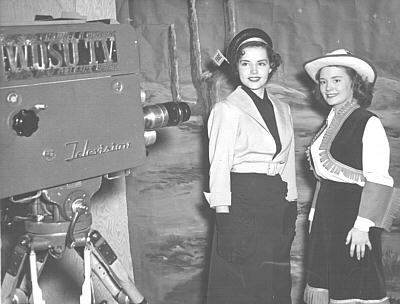
Lena Richards Cooking Show
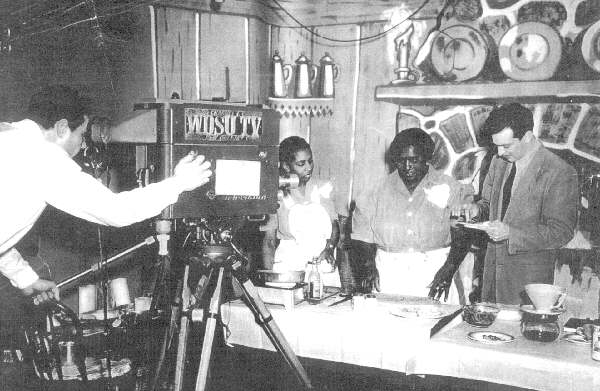
Byron Dowty - First TV Sportscaster in Louisiana
WDSU-TV's first Sports Director and Director of Special Events
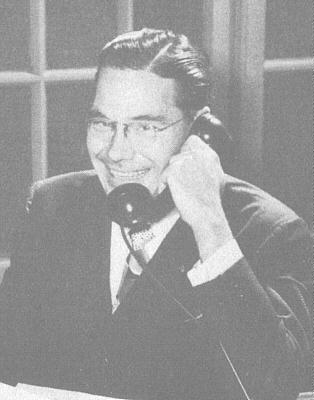 Byron Dowty was acclaimed one of the South's top ranking sportscasters.
Byron came to Channel 6 from KALB, Alexandria, LA, where he was Program
Manager. Byron was the first local TV sportscaster to do TV play-by-play
of the Sugar Bowl Grid Classic.
Byron Dowty was acclaimed one of the South's top ranking sportscasters.
Byron came to Channel 6 from KALB, Alexandria, LA, where he was Program
Manager. Byron was the first local TV sportscaster to do TV play-by-play
of the Sugar Bowl Grid Classic.
Joyce Smith
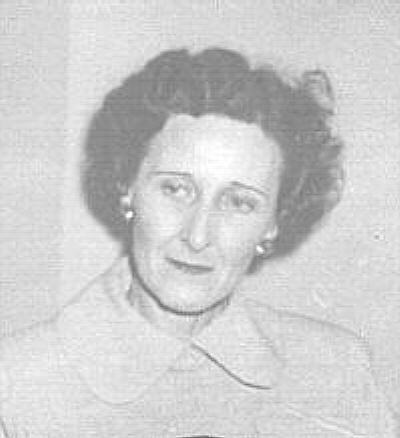
Joyce Smith was one of the first women to have a regularly scheduled television
program in the city of New Orleans. She hosted a garden show and demonstrated the
the "hows and whys" of gardening in the Gulf South.
Sam Page as "Captain Sam"
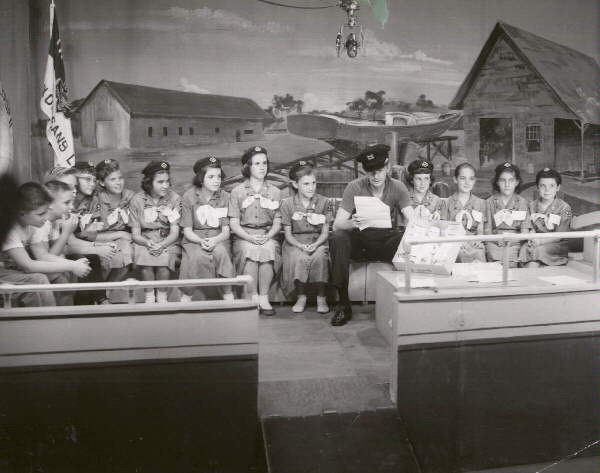
The Captain Sam Show was one of the earliest kiddie shows in the Deep South. The program's host, Sam Page, quickly became a favorite of the children in New Orleans. There was always a waiting list of children who wanted (or whose parents wanted them) to be one of Sam's guests on the program. Sam's winning ways with kids made each guest feel like the star of the show. In years to come, many men and women of New Orleans would write letters to WDSU-TV recalling their visits to the Captain Sam program.
Bayou Bill
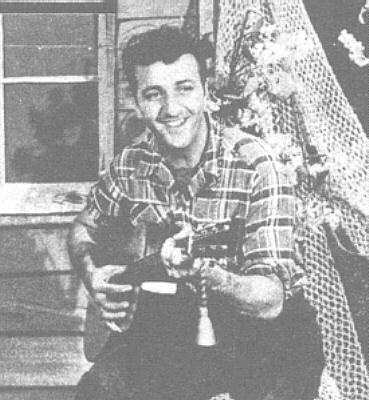
Pat Tobin and Carl Junker
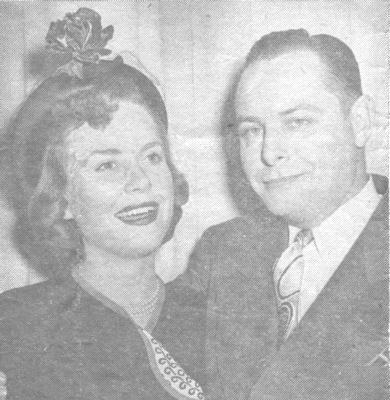
Pat Tobin graduated frm Newcomb College and began working as a secretary
to the vice-president of Tulane University. She loved the theater and
appeared as the lead in the Tulane production of the Gilbert and Sullivan
favorite, "The Mikado." D. H. Holmes VIPs saw her and immediately requested
her to represent the store at an RCA television demonstration. WDSU-TV VIP's
then asked her to do her own television program, "A Date With Pat" The
comely Pat reigned over the 1948 Comus ball masque. In her syndicated
column, Hedda Hopper named Pat Tobin as the prettiest debutante she had
ever seen. In the above picture, Pat is shown with Carl Junker, a veteran
radio announcer whose baritone voice blended beautifully with hers. The
Tobin-Junker team sang popular and semi-classical ballads to recorded
accompaniment. Junker, then a staff announcer for WDSU-TV later became an
Operations Director for the station. Pat and Carl were seen at 7:30 - 7:45
PM Monday through Saturday (except Wednesday).
Vera Massey
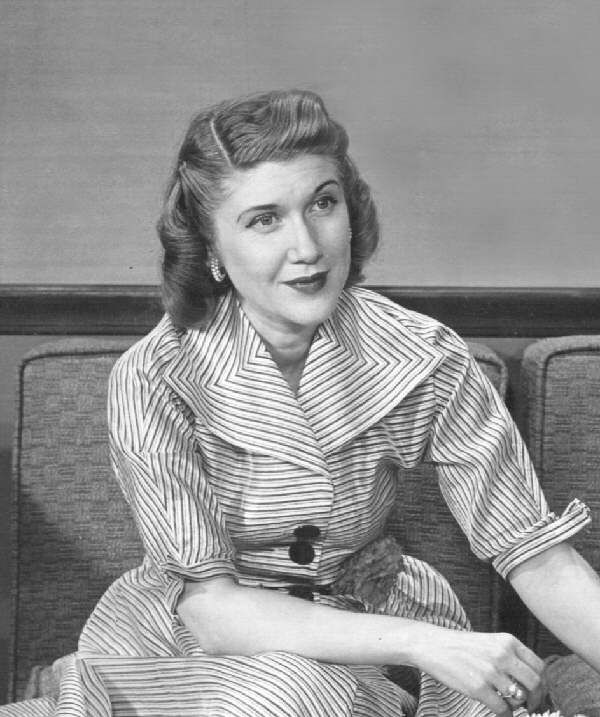
>
Bob Howard and Vera Massey star in "Our House"
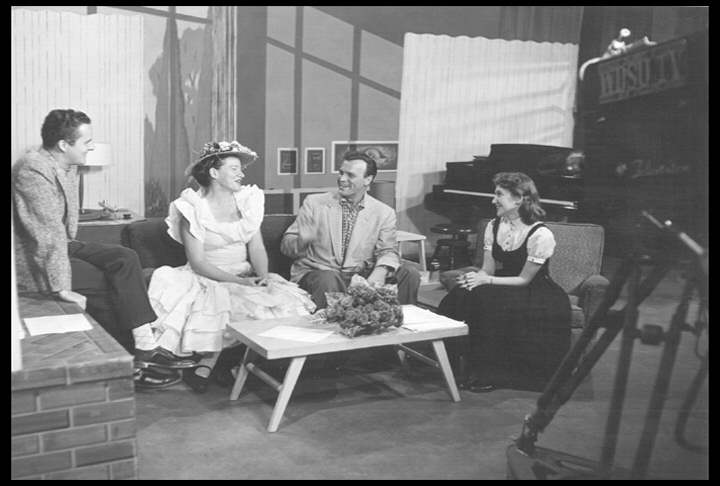
Minnie Pearl on "Our House"
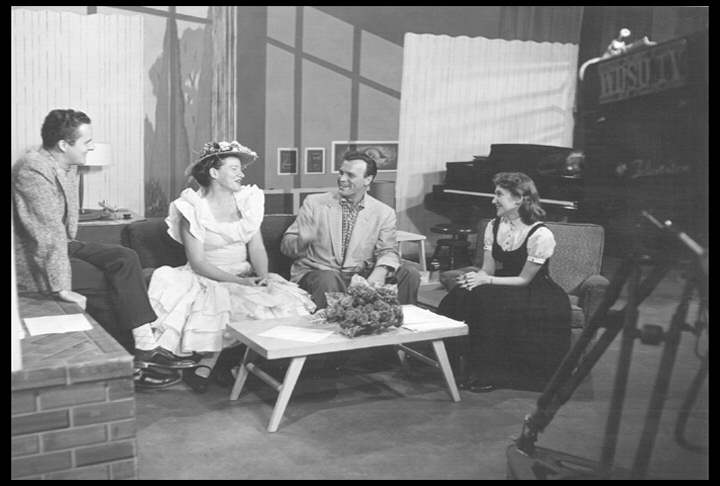
One of the great ladies of WDSU-TV, Vera Massey was a most gracious
hostess of the Ch. 6 "Our House". The delightful lady suffered from
muscular dystrophy and had to be carried on to and off of the "Our House"
set by her husband, Robbie Robinson - a WDSU-TV floor director. She showed
no outward signs of her malady and her pain while she was on the air. The
television audience never suspected that the wonderfiul lady was stricken
with the terrible disease.
Vera's first co-host was Claude Evans, who was a WDSU-TV staffer for a
while. When the owners of WDSU-TV bought WALA-TV, Channel 10, in Claude's
home town of Mobile, Alabama, Claude transferred to that station. He was
replaced on the "Our House" program by Bob Howard, a popular WDSU radio
of the 50s, shown with Vera in yhe picture above. Bob had been using the
name "Bob Hamilton" but opted for his real name when he began co-hosting
"Our House" The handsome gentleman was an immediate favorite of the ladies
of the television audience. His radio listening audience also increased
with his television appearances.
Bob's popularity with the teenage schoolgirls of the city led to a rather
serious incident that transpired in the radio studio section of the WDSU
studios. The hallway, shown on lower floor plan of the studios and labelled
as a "studio lounge" which it definitely was not...it WAS a hallway! (See
WDSU Page 3) The hallway did, however, contain
a few rows of folding chairs along the Royal Street wall. A television set
was mounted on a riser in front of the chairs. Visitors to the studio would
sometimes sit in the chair to watch shows on the air during their visit.
The rows of chairs also allowed visitors to look into the radio studios
"A" and "B" and observe the radio personalities. Word spread among the
city's schoolgirls that this area was open to the general public and
eventually several teenages made the hallway an almost daily stopover on
their way home from school. One of the young ladies kept a diary in which
she fantasized an intimate relationship with Bob. The teenage girl's father
managed to read the diary and in a raging fury came into the studio hallway
with some kind of firearm and threatened to shoot Howard through the glass
window of the studio. Howard was not hurt and the trouble ended when the
young lady told police and her irate father that the diary was pure fiction.
The incident ended un-escorted visitors roaming in the studio area and the
hallway chairs were removed.
The studios were never under heavy security but employees were a just a
little more careful about strangers in the building. Being a news oriented
facility, not every viewer or listener was happy with all news reported by
the radio and television stations. There were a couple of bomb threats that
forced evacuation by all but persons actively engaged in the presentation
of on-air programs....and those who stayed were performing strictly on a
voluntary basis. To their credit, there was never a program lost because
of bomb threats.
GO TO WDSU-TV ON AIR PAGE 2
GO TO WDSU-TV ON AIR PAGE 3
GO TO WDSU-TV ON AIR PAGE 4
GO TO WDSU-TV ON AIR PAGE 5
GO TO WDSU-TV ON AIR PAGE 6
GO TO WDSU-TV ON AIR PAGE 7
GO TO WDSU-TV PERSONNEL Page 1
GO TO WDSU-TV PERSONNEL Page 2
GO TO WDSU-TV PERSONNEL Page 3
GO TO WDSU-TV MEMBERS OF THE GNOBA HALL OF FAME
GO TO WDSU Page 1
GO TO WDSU Page 2
GO TO WDSU Page 3
GO TO WDSU Page 4
RETURN TO BROADCAST ARTS MUSEUM
For more New Orleans radio and television memories:
GO TO
"NEW ORLEANS RADIO AND TV SHRINE"



















